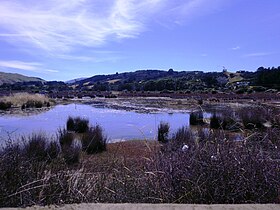Pāuatahanui Wildlife Reserve
Coordinates: 41°06′09″S 174°54′52″E / 41.10246°S 174.91436°E
| Pāuatahanui Wildlife Reserve | |
|---|---|
 Royal spoonbills and Pied stilts | |
 | |
| Location | Porirua, New Zealand |
| Area | 50 hectares (120 acres) |
| Created | 1984 |
| Operated by | Department of Conservation, Forest & Bird |
Pāuatahanui Wildlife Reserve is a wetland reserve at the eastern edge of the Pāuatahanui Inlet of the Porirua Harbour in Porirua, New Zealand. The reserve contains the most significant area of saltmarsh in the lower North Island of New Zealand. It also includes tidal mudflats, shrub lands and regenerating coastal forest. The reserve covers 50 hectares (120 acres), of which the Department of Conservation owns 46 hectares, and Forest & Bird owns the remaining 4 hectares under covenant to the Queen Elizabeth II Trust. The reserve is managed by a committee of Forest & Bird representatives in association with the Department of Conservation.[1][2]
History[]
The area had previously degraded into a wasteland that included a go-cart track, playing fields, demolition spoil, farm land and a cattleyards.[3] Work on restoration began in 1984.[2]
In 1985 the area was made into a Wildlife Management Reserve. This involved the development of ponds, walking tracks and viewing hides.[4] The reserve was officially opened on 15 April 1989.[5]
In the Wellingtonian of the Year awards 2009, Wanda Tate was recognised with the Environment Award, for 17 years work on restoring the Pāuatahanui Wildlife Reserve. Tate also won the Annual National Golden Spade award from Forest and Bird,[6] and a QSM for her work on conservation.[7][8]
Plants[]
The habitats in the reserve range from tidal mudflats to coastal forest. The main wetland species are reeds, rushes, harakeke, raupō, glasswort, sea primrose, New Zealand spinach, half-star, and wild celery. The coastal scrub includes coastal tree daisy, marsh ribbonwood, ngaio, taupata, kãnuka and mānuka. The rare succulent Thyridia repens is also found.[1]
Birds[]
Many different native and exotic birds can be found at the Pāuatahanui Wildlife Reserve, including the bar-tailed godwit, royal spoonbill, caspian tern, paradise duck, pied stilt, sacred kingfisher, white-faced heron, Australasian shoveler, pukeko and .[1]
In the areas of regenerating bush, the birds that can be seen include tūī, grey warblers and fantails.[3]
In April 2017, twenty-two fernbirds were released into the reserve, in a translocation from Lake Rotokare Scenic Reserve in Taranaki.[3] Fernbirds have been seen in the reserve in the following years.[9]
Freshwater fish[]
The Pāuatahanui stream flows through the wildlife reserve at the south-eastern corner of the inlet. This stream provides habitat for native and threatened fish species including inanga, longfin eel, giant kōkopu, and redfin bully.[10]
Gallery[]
- Pāuatahanui wildlife reserve
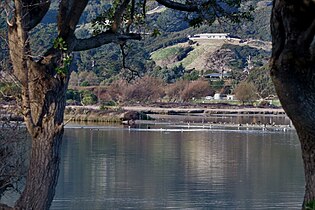
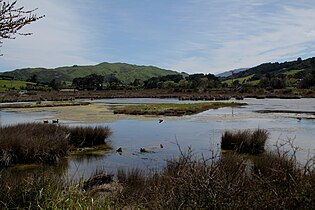


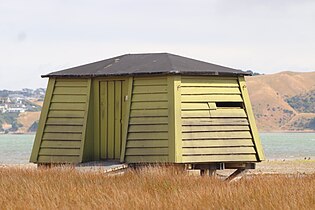
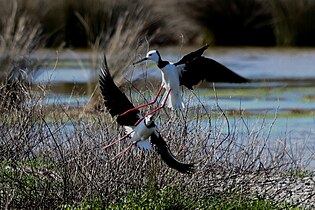
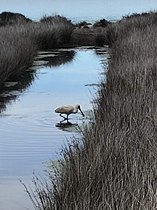

References[]
- ^ a b c "Pauatahanui Wildlife Reserve" (PDF). Department of Conservation. December 2010. Archived (PDF) from the original on 8 October 2021. Retrieved 25 December 2015.
- ^ a b "Pauatahanui's Special Ecosystems". Forest & Bird. 5 November 2018. Archived from the original on 8 October 2021. Retrieved 8 October 2021.
- ^ a b c Brooks, David (2017). "Shh... fernbirds are here". Forest & Bird (364): 30–31 – via National Library of New Zealand.
- ^ "Wildlife reserve". Guardians of the Pāuatahanui Inlet. Archived from the original on 8 October 2021. Retrieved 9 January 2013.
- ^ "Items of Interest - Pauatahanui". poriruacity.com. Retrieved 10 January 2013.[dead link]
- ^ "Forest & Bird awards Golden Spade to volunteer". Scoop. 4 June 2009. Retrieved 15 October 2021.
- ^ Newton, Kate (27 November 2009). "Taste of success for Logan Brown duo". Stuff. Retrieved 14 October 2021.
- ^ "Investitures ceremonies at Wellington's Premier House". Office of the Governor-General. 31 August 2009. Retrieved 14 October 2021.
{{cite web}}: CS1 maint: url-status (link) - ^ "Rare birds take flight in wildlife reserve". Greater Wellington. 17 June 2019. Retrieved 14 October 2021.
{{cite web}}: CS1 maint: url-status (link) - ^ "Pauatahanui Stream". Land and Water Aotearoa. Retrieved 14 October 2021.
External links[]
| Wikimedia Commons has media related to Pauatahanui Wildlife Reserve. |
- Protected areas of the Wellington Region
- Wetlands of New Zealand
- Nature reserves in New Zealand
- Landforms of the Wellington Region




